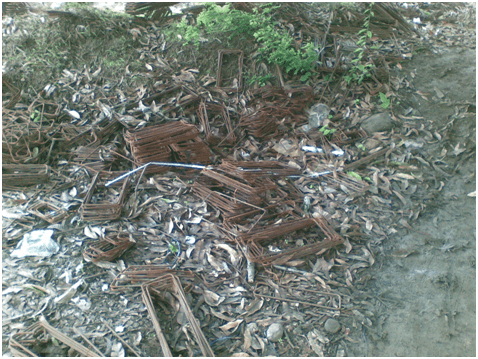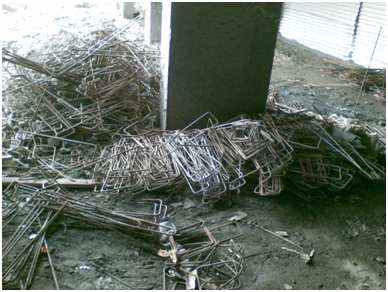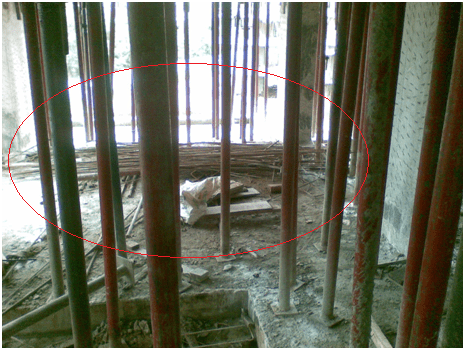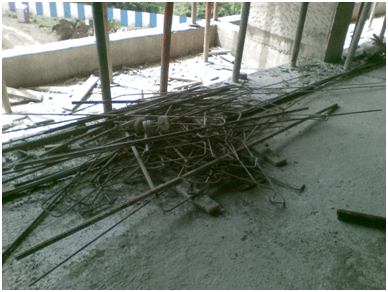How to Control Reinforcement Steel Wastage at Construction Projects
Wastage of steel is big factor at any construction project; many do reconciliation of steel received and used at project but fails to show the wastage quantity physically and keep on thinking where that wastage steel gone and base on assumption make following statements.
You may be aware about the tolerances for mass of steel given in IS 1786
If you open IS 1786 and go to clause Number 7.2.2 Table Number 2, you will find
For up to and including 10mm Dia bar – It allows +/- 7% deviation from standard weight.
For Over 10mm up to and including 16mm Dia Bar – It allows +/- 5% deviation from standard weight and,
For above 16mm Dia bar – it allows +/-3% deviation from standard weight.
What does it mean?
Example: I received a 12mm Dia bar lot at site and if I cut a bar of 1 meter length from it, then it weight should be 0.888 Kg/Meter as per standard.
If I weight it and find its weight as 0.932 Kg/meter – Is it acceptable?
Yes, that rebar lot is acceptable as per IS 1786 and you can’t reject it. Manufacturer did production of steel within the tolerance limit specified in IS 1786.
Here in this example steel is overweight by 5% and is within tolerance limit specified in IS 1786.
If you receive overweight steel from supplier and it is blindly accepted, You lost your wastage % limit at the time when you accepted such lot and this steel becomes unaccounted, You can’t even justify where your steel gone and you can only make above statements which I written at the start of this post.
If allowable wastage is 3% and my steel is overweight above 3% then I need to order more steel to complete the work as you going to make wastage during cutting of steel due to standard length of bar from which you cut the steel (This is unavoidable unless you buy a precut length bar of your desired length. At Civil4M in my next post I will write article on how to utilize those wasted steel bar and save the money)
This is the primary wastage cause without really wasting it.
How you can control it?
Buy steel from primary steel manufacturer, it is manufactured near to accurate standard weight or slightly underweight.
In primary steel too some manufacturer like RINL, you may also end up in buying overweight steel.
If you buy Secondary Re-rolled steel, the weight of steel depends on the quality of manufacturer and in most cases you will end up in buying overweight steel.
Do you mean I should not buy Secondary Steel?
No, but you should prefer Primary Steel and in both cases you should check the weight of steel received at site.
How I can control the overweight issue?
IS 1786 Never says you should follow tolerances given for mass strictly, unless otherwise it is agreed between manufacturer and purchaser.
This means if you specify the manufacturer, I will only accept steel if its within tolerance limit which is stated by us, then he is bound to supply you as per specification provided by you and if it is not as per that, You can reject the lot of steel received at construction project.
Peoples, who understand it, can make miracle and do value addition to their company.
How I can specify them the tolerance limits?
I can specify them by adding it into the purchase order which I provide them for doing supply.
Example: (This is purely an example, you use your mind during specifying your requirements, you can use it but you should know, what you are doing)
Clause in Purchase order
We accept Reinforcement steel as per below Tolerance limits specified by us and you are bound to supply material as per this only.
For up to and including 10mm Dia bar – (-)7% and +2%.
For Over 10mm up to and including 16mm Dia Bar – (-)5% and +2%.
For above 16mm Dia bar – (-)3% and +1%.
Material received beyond overweight tolerance limit will be debited to you for same amount of weight.
Material received below underweight limit will be rejected.
What these clauses exactly do?
It ensure no wastage occurs when you receive steel at your project as manufacturer will tend to produce steel in limit which are more flexible i.e.- he will try to produce underweight so he will achieve at least a standard weight and never goes to overweight side.
Above thing is called Engineering, we should use Engineering on such points to keep project going on without need of extra spending. Civil4M tries to share such knowledge will all. (Any members have good knowledge in any Civil Engineering field can share it with other members and help all to become Better Civil Engineers).
So now we will not make above statement written at start of post and knows exactly where my steel is going.
To be more accurate on this Engineer should prepare a Rolling Margin sheet which convert all steel to theoretically exact weights and help in reconciliation of steel – its again a big topic so will discuss this in another post.
Other factors of wastage in Reinforcement steel;
Rebar Cutting and Bending Gang
Have you ever wondered, why some fitter keep on making stirrups / Rings.
If you look at it closely, you will find that the fitter makes rings without any calculations on how much required and what will happen if I make more stirrups than required (Steel is free, so it does not make him to worry).
He only concern with how much he made, base on that he get paid.
Same with other fitters too, they keep on cutting bars without thinking of wastage.


Reinforcement Bars should be cut and bend only in quantity specified on Bar Bending Schedule and to achieve this only specified number of bars given to contractor for doing work and each day reconciliation of it to be done before providing him next number of bars required for next work.
If you had ever taken round on project site and observed it (I am not saying about just simply visiting by keeping mind at home), You will find Cut steel bars, rings / stirrup etc abandon everywhere, around building, on each floor (Even if work is going on at 20th floor you will find steel on 1st floor, in any amount from less to large quantity and not even stacked properly)
When Bell rang from top, all of sudden everyone get to task to clean floors and then those bars, stirrups are collected and thrown to one place just like it’s a waste (No one goes to that stack to do sorting and using it, this happens for 2 or 3 days when issue is hot, later all goes into wastage and we scrap it).
Why steel bars seen everywhere when work is going on only at 1 floor?
We only see and do not observe. If we make observations, you will not have scrap at your project.



I hope this article will turn up a useful for you and you will make some value addition at you project, here at Civil4M will post some more articles regarding Reinforcement steel
How to do rolling margin, achieve less wastage and proudly do reconciliation.
How to make use of wastage / scrap bars. Save the money, instead of selling it in scrap.
How we can make Bar Bending Schedule in simple steps - Click Here.
How we can control, cutting and bending of reinforcement steel.
Wastage of steel is big factor at any construction project; many do reconciliation of steel received and used at project but fails to show the wastage quantity physically and keep on thinking where that wastage steel gone and base on assumption make following statements.
- Steel may have got stolen from site.
- Contractor had thrown it inside the filling at plinth level and around building.
- No records provided from site for use of extra steel and so on.
You may be aware about the tolerances for mass of steel given in IS 1786
If you open IS 1786 and go to clause Number 7.2.2 Table Number 2, you will find
For up to and including 10mm Dia bar – It allows +/- 7% deviation from standard weight.
For Over 10mm up to and including 16mm Dia Bar – It allows +/- 5% deviation from standard weight and,
For above 16mm Dia bar – it allows +/-3% deviation from standard weight.
What does it mean?
Example: I received a 12mm Dia bar lot at site and if I cut a bar of 1 meter length from it, then it weight should be 0.888 Kg/Meter as per standard.
If I weight it and find its weight as 0.932 Kg/meter – Is it acceptable?
Yes, that rebar lot is acceptable as per IS 1786 and you can’t reject it. Manufacturer did production of steel within the tolerance limit specified in IS 1786.
Here in this example steel is overweight by 5% and is within tolerance limit specified in IS 1786.
If you receive overweight steel from supplier and it is blindly accepted, You lost your wastage % limit at the time when you accepted such lot and this steel becomes unaccounted, You can’t even justify where your steel gone and you can only make above statements which I written at the start of this post.
If allowable wastage is 3% and my steel is overweight above 3% then I need to order more steel to complete the work as you going to make wastage during cutting of steel due to standard length of bar from which you cut the steel (This is unavoidable unless you buy a precut length bar of your desired length. At Civil4M in my next post I will write article on how to utilize those wasted steel bar and save the money)
This is the primary wastage cause without really wasting it.
How you can control it?
Buy steel from primary steel manufacturer, it is manufactured near to accurate standard weight or slightly underweight.
In primary steel too some manufacturer like RINL, you may also end up in buying overweight steel.
If you buy Secondary Re-rolled steel, the weight of steel depends on the quality of manufacturer and in most cases you will end up in buying overweight steel.
Do you mean I should not buy Secondary Steel?
No, but you should prefer Primary Steel and in both cases you should check the weight of steel received at site.
How I can control the overweight issue?
IS 1786 Never says you should follow tolerances given for mass strictly, unless otherwise it is agreed between manufacturer and purchaser.
This means if you specify the manufacturer, I will only accept steel if its within tolerance limit which is stated by us, then he is bound to supply you as per specification provided by you and if it is not as per that, You can reject the lot of steel received at construction project.
Peoples, who understand it, can make miracle and do value addition to their company.
How I can specify them the tolerance limits?
I can specify them by adding it into the purchase order which I provide them for doing supply.
Example: (This is purely an example, you use your mind during specifying your requirements, you can use it but you should know, what you are doing)
Clause in Purchase order
We accept Reinforcement steel as per below Tolerance limits specified by us and you are bound to supply material as per this only.
For up to and including 10mm Dia bar – (-)7% and +2%.
For Over 10mm up to and including 16mm Dia Bar – (-)5% and +2%.
For above 16mm Dia bar – (-)3% and +1%.
Material received beyond overweight tolerance limit will be debited to you for same amount of weight.
Material received below underweight limit will be rejected.
What these clauses exactly do?
It ensure no wastage occurs when you receive steel at your project as manufacturer will tend to produce steel in limit which are more flexible i.e.- he will try to produce underweight so he will achieve at least a standard weight and never goes to overweight side.
Above thing is called Engineering, we should use Engineering on such points to keep project going on without need of extra spending. Civil4M tries to share such knowledge will all. (Any members have good knowledge in any Civil Engineering field can share it with other members and help all to become Better Civil Engineers).
So now we will not make above statement written at start of post and knows exactly where my steel is going.
To be more accurate on this Engineer should prepare a Rolling Margin sheet which convert all steel to theoretically exact weights and help in reconciliation of steel – its again a big topic so will discuss this in another post.
Other factors of wastage in Reinforcement steel;
Rebar Cutting and Bending Gang
Have you ever wondered, why some fitter keep on making stirrups / Rings.
If you look at it closely, you will find that the fitter makes rings without any calculations on how much required and what will happen if I make more stirrups than required (Steel is free, so it does not make him to worry).
He only concern with how much he made, base on that he get paid.
Same with other fitters too, they keep on cutting bars without thinking of wastage.


Reinforcement Bars should be cut and bend only in quantity specified on Bar Bending Schedule and to achieve this only specified number of bars given to contractor for doing work and each day reconciliation of it to be done before providing him next number of bars required for next work.
If you had ever taken round on project site and observed it (I am not saying about just simply visiting by keeping mind at home), You will find Cut steel bars, rings / stirrup etc abandon everywhere, around building, on each floor (Even if work is going on at 20th floor you will find steel on 1st floor, in any amount from less to large quantity and not even stacked properly)
When Bell rang from top, all of sudden everyone get to task to clean floors and then those bars, stirrups are collected and thrown to one place just like it’s a waste (No one goes to that stack to do sorting and using it, this happens for 2 or 3 days when issue is hot, later all goes into wastage and we scrap it).
Why steel bars seen everywhere when work is going on only at 1 floor?
We only see and do not observe. If we make observations, you will not have scrap at your project.



I hope this article will turn up a useful for you and you will make some value addition at you project, here at Civil4M will post some more articles regarding Reinforcement steel
How to do rolling margin, achieve less wastage and proudly do reconciliation.
How to make use of wastage / scrap bars. Save the money, instead of selling it in scrap.
How we can make Bar Bending Schedule in simple steps - Click Here.
How we can control, cutting and bending of reinforcement steel.
